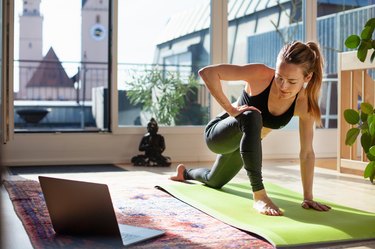
Ugh, cramps. You know what we mean. Menstrual cramps are very common: More than half of people who have periods get them, according to the Office on Women's Health.
It helps to understand why you may be doubling over in discomfort: Menstrual blood itself is an irritant to your uterus, Shannon Schellhammer, MD, an ob-gyn at Orlando Health Winnie Palmer, tells LIVESTRONG.com. The result of that irritation is inflammation, which triggers uterine muscles to cramp. Therefore, menstrual cramp cures that decrease inflammation or lessen bleeding can help treat the pain.
Video of the Day
Video of the Day
In addition, there's a hormonal change. Your body releases prostaglandins, hormones that help the uterus shed its lining, ob-gyn Kelly Culwell, MD, tells LIVESTRONG.com. Prostaglandins not only cause the uterus to cramp, but they also affect surrounding organs. "Prostaglandins can also affect the bowels and bladder. You may experience more intestinal cramping or diarrhea," she says. (Hello, period poops and period farts.)
When it comes to getting rid of period cramps, it's important to keep in mind that what works for one person might not work for another, Dr. Culwell says. You might find that a remedy that science shows is effective does nada for you, while a complementary therapy that doesn't have much data behind it zaps your cramps into submission. "If you find something that works for you and it is not harmful, then go for it," she says.
Next time you're feeling uneasy and cramped up, try one of these home remedies for menstrual cramps to relieve the pain quickly:
1. Pop a Non-Steroidal Anti-Inflammatory Medication
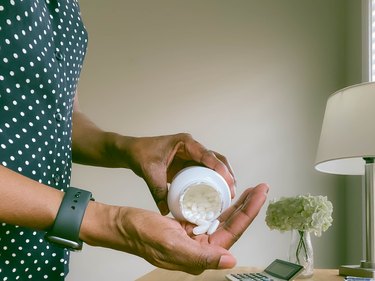
To get rid of cramps fast, take an NSAID, also called non-steroidal anti-inflammatory medication, which include over-the-counter pain relievers ibuprofen (Advil, Motrin) and naproxen (Aleve). "These can help you manage period cramps so that you can continue to go to work or school and live your daily life," says Dr. Culwell.
The trick with NSAIDs is that you want to take enough — but not too much. Dr. Culwell suggests taking 600 milligrams (mg) every six hours. (That's typically three tablets, but check the label to be sure.)
You can take these in reaction to cramping, but it's even better if you use them to prevent it from happening in the first place.
If you know the time of your cycle when you start to feel cramping coming on — it's different for everyone, but it's often just before your period or during the first couple days of bleeding — Dr. Culwell advises starting about a day earlier. Meaning, if you expect cramping on day one, then start the day before, and continue until a day or two after you expect cramping to resolve. In total, you may be popping an NSAID routinely for three or four days straight.
NSAIDs aren't a magic cure by any means. Meds have real side effects, primarily stomach upset. If you have ulcers, gastritis or another GI condition, or you notice that NSAIDs cause digestive distress, talk to your doctor before starting this regimen, Dr. Culwell says.
Try These NSAIDs
- Amazon Basic Care Ibuprofen Tablets: Amazon ($15.02 for 500 tablets)
- Advil Liqui-Gels: Amazon ($18.32 for 200); Walmart.com ($17.18 for 200)
- Motrin IB: Amazon ($13.78 for 225); CVS.com ($6.79 for 24)
2. Try Acetaminophen
Acetaminopen (Tylenol) isn't just useful as a fever-reducer. This OTC is also a pain reliever for cramps, says Dr. Culwell. The dose differs from NSAIDs, though — that's why it's important to look at the bottle first to check if yours is regular or extra-strength in order to dole out the correct dose.
Pay attention to the max dose listed. For example, you should not take more than 3,000 milligrams of extra-strength Tylenol in 24 hours (unless your doc tells you otherwise), per the brand's website. Overdosing on Tylenol can cause liver damage.
Try These Acetaminophen Products
- Tylenol Extra Strength Caplets: Amazon ($9.79 for 100); RiteAid.com ($9.99 for 100)
- Amazon Basic Care Extra Strength Pain Relief: Amazon ($8.66 for 200)
3. Use a Heating Pad
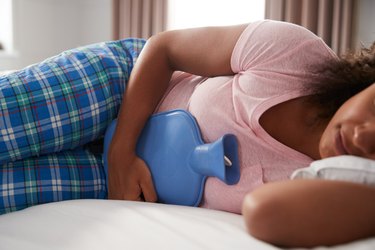
If you can't take an over-the-counter medication (or would like to avoid doing so), try a heating pad for cramps. Some data shows that heat therapy relieves menstrual cramps better than a placebo, and some find that it's just as effective as pain relief medication, according to a November 2018 review and meta-analysis in Scientific Reports.
There are several different types of heating pads available, from those that plug in, to hot water bottles and even buckwheat versions that are warmed in the microwave. "One is not better than the other. Choose the heating pad type that feels most comfortable to you and does not get too hot for your skin," Dr. Schellhammer says.
One benefit to buckwheat warmers is that they are nice and flexible, so you can drape them over your belly, and they have some nice weight to them, Dr. Culwell adds. That said, you will have to reheat these. Always follow the directions, as microwaving them too long can make them really hot and possibly lead to burns.
If you don't have a heating pad, try a warm compress, which can be made by soaking a towel in warm water. While this will require you to reheat it multiple times, it can help in a pinch.
Try These Heating Pads
4. Take a Warm Shower or Bath
Heat can work in other ways, too. Step into a warm shower or lay in a bath when you have cramps. That already sounds soothing, right?
"The warmth helps to relax the muscles around the pelvic area, and that can help relieve some of the cramping," Dr. Culwell says. (And yes, you can take a bath when you're on your period.)
5. Avoid or Limit Gassy Foods
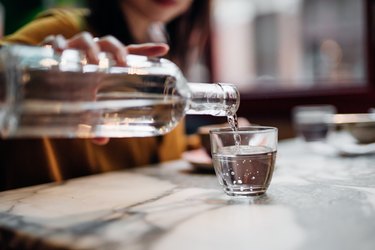
What causes your belly to bloat? We all have our own triggers (carbonated drinks, like flavored seltzers, are common culprits), so learning yours can pay off during period time.
"Your uterus is in the same area as your intestines. Anything that increases bloating will push on your uterus and could make it cramp more," Dr. Schellhammer says.
So, while no food can get rid of period cramps (even chocolate!), avoiding gassy foods in favor of those that go easy on your stomach is a good idea. Beyond fizzy drinks, common culprits include:
- Foods with sugar alcohols (think: low-cal packaged snacks, candy, gum)
- Legumes (beans, chickpeas, lentils)
- Cruciferous veggies (broccoli, Brussels sprouts, cabbage, cauliflower)
- Dairy
- Fried foods
- Onions and garlic
6. Limit Sugary Fare
In addition to the above diet changes, now's the time to take a look at your overall sugar intake, Dr. Culwell says. "Studies support the fact that a diet high in refined sugars can contribute to worsening of menstrual cramps," she says.
For instance, May 2018 research in BMC Women's Health concluded that consuming foods high in sugar and salt were linked to an increased risk of menstrual pain.
Beyond sugary drinks and candy, foods with added sugar to watch out for include:
- Flavored yogurt
- Condiments like ketchup and barbecue sauce
- Kombucha
- Some plant-based milks
- Packaged fruits
- Granola
- Packaged oatmeal
- Flavored coffees
7. Sip Some Herbal Tea

Sipping something warm can be inherently comforting, but certain herbals my be better than others when it comes to period cramps.
There's some evidence that both mint and ginger may offer pain relief that's superior to a placebo. Data shows that oral ginger may be just as good as NSAIDs for diminishing discomfort, according to a May 2016 review and meta-analysis in Evidence-Based Complementary and Alternative Medicine. Ginger may have anti-inflammatory and pain-relieving properties, and it may suppress prostaglandin production.
Mint, for its part, contains menthol, a compound that triggers certain receptors in the body that may quell pain, and it may also ease muscle contractions, according to a July-August 2016 study in the Iranian Journal of Nursing and Midwifery Research. Though, anti-inflammatory medication was still found to be better at stifling pain compared to peppermint.
While more high-quality research is needed, it is clear that mint and ginger are safe to try.
Try These Teas
8. Get Some Exercise
If you're lying in bed, the last thing you might want to do is get up and move around. And that's understandable.
"For some people, exercise makes them feel better, and some feel worse," Dr. Schellhammer says.
If you're more on the "yeah, definitely not" side, then that's fine — try some of the other remedies here. But also consider physical activity a day or two before your expected period, Dr. Culwell suggests.
Your workout can be anything you're up for, including HIIT or lifting heavy weights, but it can also be gentle walking, stretching or relaxing yoga.
"Some studies have shown that exercise reduces some of the response to cramping and pain and helps women feel better," Dr. Culwell says.
Swimming can also feel nice, adds Dr. Schellhammer, as the water's buoyancy will support you as you move.
Related Reading
9. Rest
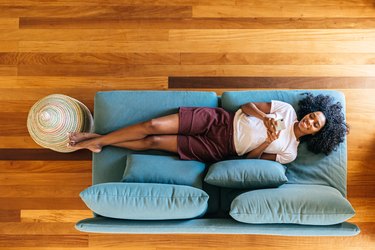
Good old-fashioned R&R — adding Netflix is optional.
Whether you sit in an easy chair, lay on the couch or snuggle in bed while relaxing is entirely up to your personal preference. "No particular position is scientifically proven to make a difference in pain levels," Dr. Schellhammer says.
Extra rest can also pay off, as research shows that people with heavier periods tend to get less sleep and poorer quality sleep, per an August 2021 report in the Journal of Sleep Research.
10. Consider Hormonal Birth Control
Cramps may be common, but being sidelined by them is not.
"To be honest, a period cramp should never impact your lifestyle to the point where you can't do the activity that you want to do," Dr. Schellhammer says. If that happens, talk to your doctor.
If you are not looking to get pregnant, your doc might recommend low-dose hormonal birth control. "These options regulate hormones to prevent fluctuations that can contribute to pain. They also can lessen bleeding, decreasing irritation and, therefore, cramps," Dr. Schellhammer says.
11. Ask About Prescription Medication

If you have heavy menstrual bleeding, your doctor may consider a prescription NSAID medication called tranexamic acid (Lysteda).
"It's a medication that really helps with the inflammation of the uterus on a different level than ibuprofen," Dr. Schellhammer says.
In a September 2019 review in the Cochrane Database of Systematic Reviews that included 19 randomized trials of 759 people, NSAIDs themselves were found to reduce heavy bleeding superior to a placebo, but tranexamic acid performed even better. (Though the data set is small and limited, say the authors.)
When to See a Doctor About Cramps
Though people who have periods have been taught that cramps are just par for the course, they can sometimes be a sign that something more is going on.
In the event that first-line treatments for cramps (those listed above) don't bring relief, then your gynecologist may consider doing an ultrasound to look for other causes, such as fibroids, a uterine polyp or evidence of endometriosis that's triggering the heavy bleeding and cramping.
And if you're experiencing unbearable period pain that gets in the way of daily life, definitely make an appointment.
"As a society, we think that every person with a period is miserable every month with cramps. That should not be the case," Dr. Schellhammer says.
- Office on Women’s Health. “Period problems”
- StatPearls: “Acetaminophen Toxicity”
- Scientific Reports: “Heat therapy for primary dysmenorrhea: A systematic review and meta-analysis of its effects on pain relief and quality of life”
- Cochrane Database of Systematic Reviews: “Non-steroidal anti-inflammatory drugs for heavy menstrual bleeding”
- Cochrane Database of Systematic Reviews: “Exercise for dysmenorrhoea”
- Evidence-Based Complementary and Alternative Medicine: “Efficacy of Oral Ginger (Zingiber officianle) for Dysmenorrhea: A Systematic Review and Meta-Analysis”
- Iranian Journal of Nursing and Midwifery Research. “Evaluation of mint efficacy regarding dysmenorrhea in comparison with mefenamic acid: A double blinded randomized crossover study”
- Journal of Sleep Research: Menstrual regularity and bleeding is associated with sleep duration, sleep quality and fatigue in a community sample
- BMC Women's Health: Major dietary patterns in relation to menstrual pain: a nested case control study
Was this article helpful?
150 Characters Max
0/150
Thank you for sharing!
Thank you for your feedback!
Is this an emergency? If you are experiencing serious medical symptoms, please see the National Library of Medicine’s list of signs you need emergency medical attention or call 911.


